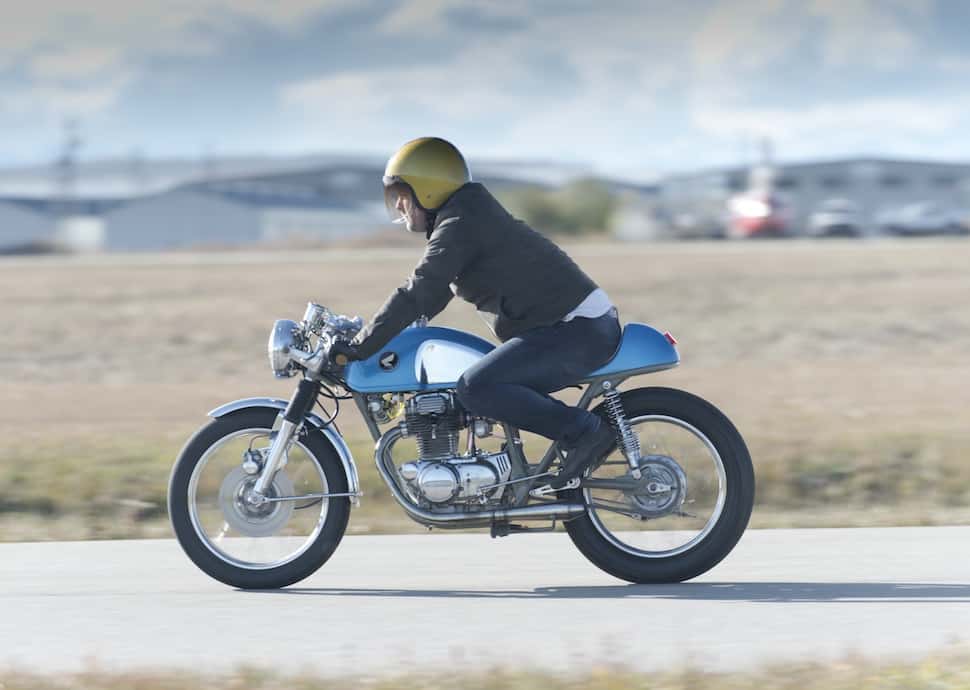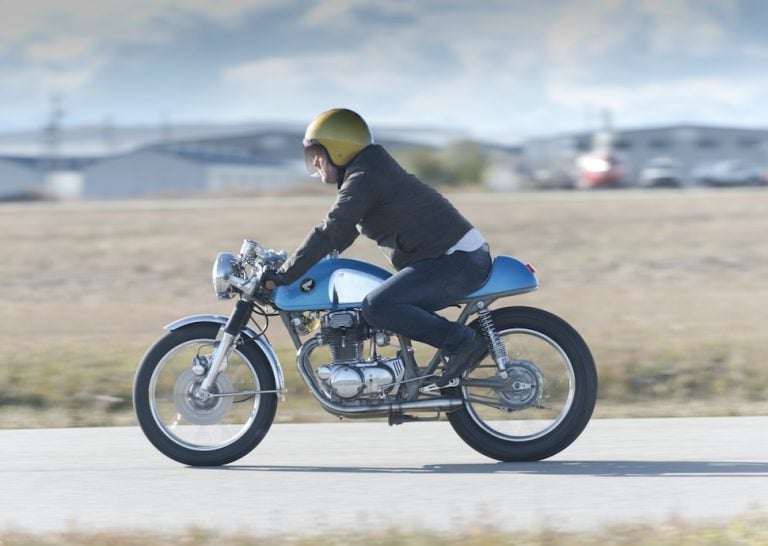This story was first published in August 2016, then updated and republished in 2024.
Project summary:
- Paid $600 for banged-up CB360 on Kijiji
- Benelli Mojave gas tank with hand-formed thin aluminum panels
- clip bars from a swap meet
- $30 swingbar from eBay
- customized rear tail section with small round light and custom aluminum panels
- custom brass dash panel with aftermarket speedometer and tachometer
- headlight from a Yamaha
- all aluminum parts polished, including fork triple trees, lower sliders, and wheels
- stock Honda CB360 wheels cleaned up with Pirelli tires (front) Avon tires (back)
- new bearings and brake pads
- stock engine polished with replaced rings, freshening up the head
- stock header pipes with a pair of small megaphones
- Mikuni VM32s with velocity stacks carburetor

“I decided I had to go full out and build something completely custom”
In the late 1980s, Philip Nelson sold his Suzuki DS80 dirt bike. He was in Grade 7, and he used the money to buy cattle. He raised the livestock on his family’s central Alberta farm and saw the purchase as a way to earn funds for college. After selling his DS80, Philip says he would occasionally reminisce about riding and thought about owning another motorcycle but never acted upon the impulse.
His dad, Rod Nelson, too, always liked to reminisce about an old Honda 305 Super Hawk he’d owned, but apart from brother Steven’s short affair with a Kawasaki Ninja in the late 1990s, none of the Nelson family had another machine. Until 2010, when Philip’s dad bought a Suzuki Boulevard.

“I went up to visit my family, took the Suzuki for a ride, and the next week, I went out and bought a Triumph Thruxton,” Philip says. “I was 35 when that happened.” Philip, who currently lives in Calgary, still owns the Thruxton.
It looked rough when I was buying it, but after I got it home I realized how rough it really was.
Bike owner, Philip Nelson
But, as a then-budding motorcycle enthusiast, Philip discovered BikeEXIF.com, a website that helps define trends in the world of custom machines. Particularly attracted to the café racer motorcycles featured on BikeEXIF, Philip decided he’d build one and purchased a 1978 Honda CB550. He removed the Windjammer fairing and bags and discovered that underneath all of the extras, he had a very nice, original machine. He made a café-style seat and installed a set of ‘ace’ drop bars, but didn’t want to go any further by cutting tabs and making irreversible changes.

When he saw the bikes coming out of Jay LaRossa’s California shop, Lossa Engineering, however, Philip couldn’t constrain himself any longer.
“I decided I had to go full out and build something completely custom,” Philip says. “So, I found this 1974 Honda CB360 on Kijiji in August, 2012.
“It looked rough when I was buying it, but after I got it home I realized how rough it really was.”
$600 Kickstarts the Honda Cafe Racer Project

According to Philip, who paid $600 for the project bike, everything was dented, and a previous owner had put the machine together poorly. As well, the front brake was seized, the forks leaked suspension fluid and the rear brake was hardly functioning. On the bright side, it ran, sort of.
Philip had sketched a side profile image to help guide the build, and he’d incorporated the enticing lines of a Benelli Mojave gas tank. He’d found one of these rare tanks on eBay, and he stripped the Honda motorcycle’s old tank and seat away to sit the Benelli tank atop the frame.

“I also had some clip on bars I’d bought at the local Millarville (vintage motorcycle) Swap Meet, and hung them on there with a different headlight up front. It was obvious that to go much further I’d have to break out the Sawzall.”
He cut away all of the tabs that held the Honda’s stock side panels and air box and also pared away the tool kit, rear passenger pegs, and the section of frame behind the shock absorber mounts. After Derek Pauletto of Calgary’s Trillion Industries welded in mounts to support the Benelli tank and a new rear frame loop, Philip stood back (literally) to admire the Honda. That’s when he discovered when viewed from behind the CB360’s rear wheel appeared cocked in the frame, and to his dismay, learned the rear swingarm was bent.

Straightening it was an option he investigated, but for the money it would cost, he found a used one on eBay, paid $30 for the replacement, and then almost double that to ship it to his doorstep. Thankfully, the eBay swingarm was straight and true.
CB360 Styling

Hand-formed fibre glass tail with customized details
Philip wanted the lines of his rear tail section to match the Benelli gas tank, and nothing he saw for sale online looked appropriate. So, he took matters into his own hands and spent two months forming a tail out of fibre glass, learning how to work with the glass mat and resin materials all the while he was making it. Into the back of the tail section he molded a small round light he sourced from U.S. custom parts supplier Dime City Cycles. Also, all of the Honda’s electrical system is tucked under the rear hump, including the battery and solid-state regulator.

Learning to work with metal, for the first time
To accentuate the curves of the Benelli tank Philip cut and hand-formed thin aluminum panels. It was the first time he’d ever done any metal forming, but he’d first made some cardboard templates and then patiently worked with a rubber hammer and a piece of hardwood dowel clamped in his bench vise to get the shape he wanted. That’s also how he made the aluminum panels gracing the tail section – these were to be trimmed with a thin pad and leather, but after seeing the polished pieces in place Philip decided to forego the covers.

Custom brass dash with aftermarket speedometer and tachometer, and a Yamaha-sourced headlight
He also made his own brass dash panel that’s located between the aftermarket speedometer and tachometer, and the headlight was another Millarville swap meet find that’s meant to be on a Yamaha.
After mocking up the bike, Philip took it all apart and sent the frame and swingarm to Calgary Powder Coating. In their hands, the chassis was treated to a grey coating that’s got a slight hint of green in it. The gas tank and tail section were dropped off with Guy St. Pierre of Cyclemania in Okotoks for the blue paint.

Stock Honda CB360 wheels with Pirelli and Avon tires
While waiting for parts to come back, Philip polished everything that was aluminum, including the fork triple trees and lower sliders. Nothing was sent out for chrome plating and Philip’s polishing wheels were given a workout in returning some of the original lustre to the front fender and rear shock springs. Both wheels are stock, simply cleaned up and treated to new bearings and tires, a Pirelli up front and an Avon out back, while new brake pads were sourced from online supplier Canada’s Motorcycle.

Stock Honda CB360 Engine with New Bits
When the engine was out of the frame Philip took the top end apart, replacing the rings and freshening up the head. He cleaned and polished the entire engine, paying meticulous attention to all of the alloy side covers. He’s running stock header pipes with a pair of small megaphones from Dime City Cycles. For carburetion, he ordered a pair Mikuni VM32s with velocity stacks, again from Dime City Cycles.
“I bolted them on there and they were almost perfectly set up for the bike,” Philip says.
Finished in 2014

The café racer was finished late in 2014 just in time for the Distinguished Gentleman’s Ride (raising funds for prostate cancer research and sponsored in part by Triumph) in Calgary. That ride was, in fact, the bike’s maiden voyage and Philip says it ran like a top – and continues to do so. There are just over 1,100 kilometres on the odometer now, and he takes the Honda CB360 on journeys to nearby destinations such as Banff, or just around town running errands.
The cattle have long since been forgotten, and motorcycles play a large role in Philip’s life. He’s now working on two Honda 305 Super Hawks, just like the one his dad once owned. One of the Super Hawks will be stock, and the other will be turned into a café racer.
Gallery (Photos by Amee Reehal):



